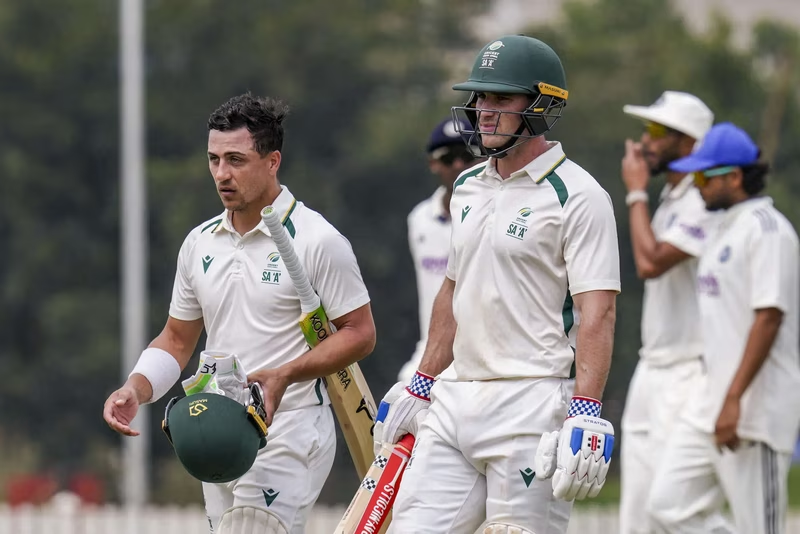South Africa A Stun India A With Record 417-Run Chase
Cricket history was rewritten in Bengaluru—and not in India’s favor. In a stunning reversal of fortune, South Africa A pulled off the highest-ever successful fourth-innings chase on Indian soil, gunning down a daunting 417 against Rishabh Pant’s India A side to level the two-match four-day series 1-1. The achievement wasn’t just about runs—it was a masterclass in collective batting, nerve, and belief under pressure .
Table of Contents
- The Record-Breaking Chase in Numbers
- How South Africa A Built the Innings
- India A’s Bowling Strategy: What Went Wrong?
- Historical Context: Fourth-Innings Chases in India
- Key Performers for South Africa A
- What This Means for Future Test Selectors
The Record-Breaking Chase in Numbers
Chasing 417 in the fourth innings is daunting anywhere—but in India, where pitches traditionally assist spin as the match wears on, it’s borderline impossible. Yet South Africa A not only attempted it, they aced it, finishing at 418/5 with more than a session to spare .
For perspective:
- Previous highest chase on Indian soil: 403 by West Indies vs India (2018, Rajkot)
- South Africa A’s run rate: 4.82 over 86.4 overs
- Half-centuries: Five batters scored 50+—a rare feat in a high-pressure chase
This wasn’t a fluke. It was calculated, composed, and utterly clinical.
How South Africa A Built the Innings
From ball one, South Africa A batted with purpose. Openers laid a solid 89-run foundation, but the real damage came in the middle order. Rather than relying on one hero, the team executed a “relay bat” strategy—each batter playing a defined role:
- Top order (1–3): See off the new ball, target loose deliveries
- Middle order (4–6): Rotate strike, attack spin, keep tempo
- Lower middle (7–8): Capitalize on set partnerships, accelerate late
Captain Matthew Breetzke (72*) and all-rounder Liam Alder (68) exemplified this approach—rotating strike intelligently and punishing anything short or wide. Crucially, they avoided the “one big hitter” trap that often derails chases.
India A’s Bowling Strategy: What Went Wrong?
India A, led by Rishabh Pant, posted a strong 421 in their second innings, banking on spin to dominate Day 4. But their bowling lacked variation and aggression:
- Over-reliance on spin: 62 of 86.4 overs bowled by spinners
- Pace lacked bite: Akash Deep and Yash Dayal bowled short but without consistent line
- No breakthroughs in clusters: Wickets came at 89, 162, 231, 302, 378—never two in quick succession
Without reverse swing or sharp turn, the pitch played flatter than expected. And South Africa A’s batters, many of whom train in subcontinental conditions, showed exceptional adaptation.
Historical Context: Fourth-Innings Chases in India
Successful 400+ chases in India are mythical. Since 1933, there have been only **three** instances of any team chasing 350+ in the fourth innings on Indian soil:
- West Indies – 403/8 vs India, Rajkot (2018)
- South Africa – 385/4 vs India, Cape Town (technically not India, but similar conditions, 2018)
- South Africa A – 418/5 vs India A, Bengaluru (2025)
As noted by ESPNcricinfo’s stats editor, “This chase redefines what’s possible in Indian conditions. It’s not just about runs—it’s about mindset” .
Key Performers for South Africa A
While it was a team effort, five batters stood out:
- Matthew Breetzke (c) – 72* (121 balls): Calm leadership, anchored the finish
- Liam Alder – 68 (94 balls): Dominated spinners with sweep and reverse-sweep
- Khanya Cotani – 61 (89 balls): Solid defense, crucial 98-run stand for 4th wicket
- Delron Bakker – 57 (76 balls): Aggressive pull shots against pace
- Jean-Pierre Kotze – 55 (68 balls): Fast start that set the tone
Notably, all scored at strike rates between 75–95—proof that control, not just power, wins big chases.
What This Means for Future Test Selectors
This performance won’t go unnoticed. The likes of Breetzke, Alder, and Cotani are now firmly in South Africa’s Test radar—especially with the senior team touring India in early 2026. Their ability to chase big totals on turning tracks directly addresses a historic weakness in South African cricket.
For India, it’s a wake-up call. As [INTERNAL_LINK:india-a-development-pathway] has previously analyzed, India A must simulate tougher, more unpredictable conditions to prepare future Test batters and bowlers for real-world challenges.
Final Thoughts
South Africa A didn’t just win a match—they shattered a myth. The belief that “big chases can’t happen in India” is officially dead. Their blend of technique, temperament, and teamwork offers a blueprint for modern red-ball cricket. For Indian cricket, the lesson is clear: dominance at home can’t be assumed. Conditions change. Opponents evolve. And history, as Bengaluru just proved, is always waiting to be rewritten.
